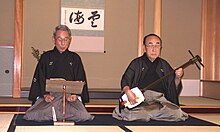
Back شاميسن Arabic Şamisen Azerbaijani Shamisen Catalan Šamisen Czech Shamisen Welsh Shamisen German Ŝamiseno Esperanto Shamisen Spanish Shamisen Basque شامیسن Persian
This article needs additional citations for verification. (June 2023) |



The shamisen (三味線), also known as sangen (三絃) or samisen (all meaning "three strings"), is a three-stringed traditional Japanese musical instrument derived from the Chinese instrument sanxian. It is played with a plectrum called a bachi.
The Japanese pronunciation is usually shamisen but sometimes jamisen when used as a suffix, according to regular sound change (e.g. tsugaru-jamisen). In Western Japanese dialects and several Edo period sources, it is both written and pronounced as samisen.
The construction of the shamisen varies in shape, depending on the genre in which it is used. The instrument used to accompany kabuki has a thin neck, facilitating the agile and virtuosic requirements of that genre. The one used to accompany puppet plays and folk songs has a longer and thicker neck instead, to match the more robust music of those genres.